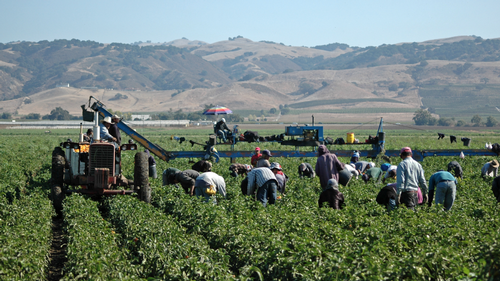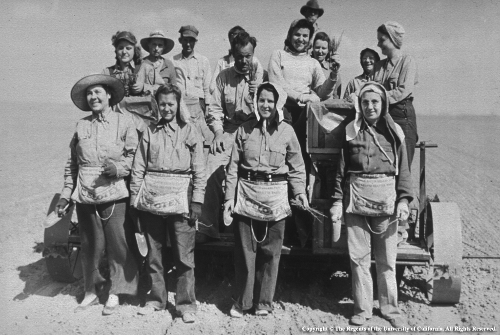Posts Tagged: labor
Understanding Labor Issues in California Agriculture
Mark here. I'm including below really nice overview of the current ag labor issue in California by colleague Laura Tourte. The intensity of work and dependence of our agriculture on labor here on the Central Coast make this topic really relevant and, given the looming changes in cost and availability, pretty important to understand well.
Growers often report – and researchers generally agree – that labor shortages exist in agriculture along the Central Coast and elsewhere in California, and that labor costs are rising. The reasons are for this situation are complex and multifaceted. Here are some considerations:
- The fresh market crops that dominate agricultural production along the Central Coast are labor intensive. Weeding, pruning and training, irrigation and harvest are examples of practices that are especially labor intensive.
- Labor represents between almost 30 and 60 percent of total production and harvest costs, depending upon the crop and crop cycle. It may be even higher for some crops grown elsewhere in California.
- Labor costs are rising, in part because of changing regulations associated with minimum wage, overtime, health care, paid sick leave and non-productive time, but also because there is a shortage of agricultural labor along with an increased demand for workers.
- Increased labor and production costs can strain and negatively impact the already thin profit margins associated with some crops.
- Immigration constraints and tightened border enforcement have reduced the number of agricultural workers from Mexico—the primary source of labor—that are seeking work in the area and state. The expanding agricultural industry in Mexico has also reduced the number of workers seeking employment here.
- The agricultural labor force is aging and more settled, and have families and other connections to local communities. Because of this, experienced workers do not migrate with the crop production and harvest cycles as often as in the past.
- Most harvest and other labor intensive practices for fresh market crops have not yet been highly mechanized or automated because of important “sensory attributes”—particularly sight and touch—that humans bring to agricultural work. Some commercially available technology already exists, and public and private research efforts are underway to mechanize or automate other labor intensive practices. Mechanical aids are also being used if available, or are being developed, with the goal of improving labor efficiency.
- Some of the area's farmers now supplement their labor forces with foreign guest workers using the federal H-2A program. The program has expanded rapidly in California in recent years increasing from roughly 3,000 certified farm jobs in fiscal year 2012 to 15,000 in fiscal year 2017. However, the program's recruitment process, requirements and associated costs limit it as a viable option for some growers.
- Affordable housing for farm workers is often lacking or constrained. Efforts to address housing issues are in discussion and in progress in the area.
The full impact of labor shortages and rising labor costs is not yet known. The Race in the Fields: Imports, Machines and Migrants, a California Agriculture article by Philip Martin, Professor Emeritus of Agricultural and Resource Economics at UC Davis considers whether current conditions will result in rising imported produce, mechanization, or more foreign guest workers in agriculture. It is also one of the sources of information for this blog article, along with other articles from California Agriculture. http://calag.ucanr.edu/. Cost information is from various cost and return studies, which can be found at https://coststudies.ucdavis.edu.

Farm labor
A Note on Employment Trends in Industries Other than Berry Agriculture
Labor easily takes top billing in most conversation concerning berry production today. While this is a very big deal for us, what does it look like outside of this industry?
A lot of the same actually.
Trucking: In spite of rising demand for freight shipment in our strengthening domestic economy, trucking businesses are hurting for drivers. Under the heading “Who's driving?” the August 28 trucking industry analysis by ValueLine, a leading stock advisory service, describes that a “worsening driver shortage is the biggest news affecting the industry today”. Truck fleets will have to either lower driver standards, raise pay or consolidate with other companies to purchase access to more drivers.
Housing: Likewise to trucking, what should come under the heading “Who's building?”, the September 21 quarterly earnings call of Lennar Corporation, one of the largest builders of single and multi-family homes in the US, alluded to labor as “having become a limiting factor” in being able to build houses. This has to be really frustrating, because the prospects for builders right now are really good – employment is up, demand is strong and consistent and Millennials, long understood to be on the sidelines of the market, are starting to form households. Nevertheless, according to the call, the entire labor market has tightened and rapid growth in the housing market will be limited by available labor.
So, are the worker shortages we face in the berry industry simply a reflection of a larger, secular shift in the labor situation in the USA? Given the above examples, one could say maybe so.
Labor: Slow Your Roll on the McDonald's Wage Hike
This article below is written for the American economy as a whole, but it is very significant for the labor intensive berry business on the Central Coast.
Bottom line is that even though McDonald's might be raising its minimum wage by 10% at 1500 outlets, this raise is only for 90,000 workers, leaving the other 750,000 working for MCD franchises without raises. The author, Josh Brown, makes the point that this supposedly large raise only comes out to be 1.1% when all McDonald's minimum wage employees are included.
Josh points out that the real value is a signaling to other workers in minimum wage industries that times are changing and pressure on wages is going in an upward direction.
http://thereformedbroker.com/2015/04/03/qotd-slow-your-roll-on-mcdonalds-wage-hike/
Immigration Reform and California Agriculture
Really great article here by UC Davis' Philip Martin concerning immigration reform bills and what they might mean for the labor situation in the agriculture of California.
http://californiaagriculture.ucanr.org/landingpage.cfm?article=ca.v067n04p196&fulltext=yes
Interestingly, it looks like the longer periods of US employment permitted by one bill, S 744, as well as the opportunity for immigrants to bring family with them, could result in a larger number of people coming here from Asia to work.
Might be a signal to start learning Mandarin Chinese.

What might the immigration reform bills making their way through Congress mean for field labor in California?
Another Fine Article on the Future of Farm Labor for California
An excellent article by the "Agricultural and Resource Economics Update" from the Giannini Foundation of Agricultural Economics of the University of California regarding the future of farm labor for California growers and beyond:
http://giannini.ucop.edu/media/are-update/files/articles/V16N4_1.pdf
Following the statement summarizing the author's research showing that the era of farm labor abundance is coming to an end, arrives the money line:
"This means that immigration policy will cease to be a solution to the U.S. farm labor problem in the long run and probably sooner. In fact, we already may be witnessing the start of a new era in which farmers will have to adapt to labor scarcity by switching to less labor intensive crops, technologies, and labor management practices."
Seriously recommended reading for those in the berry business.

